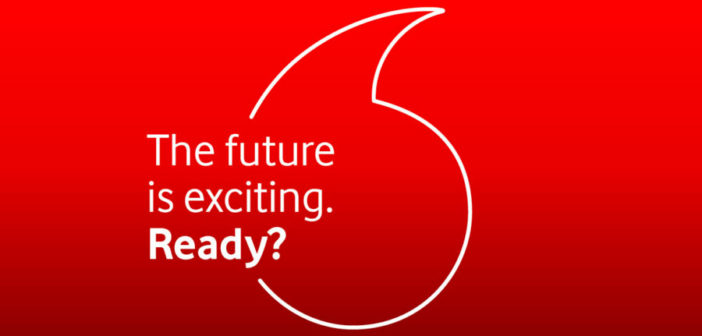Vodafone is opting for optimism in a new global brand positioning campaign that is rolling out across the 36 countries where it operates. It’s the brand’s first refresh since the 2009 introduction of its ‘Power to you’ tagline (which retires with this brand refresh) and underscores the brands belief that new technologies and digital services can have a positive impact on enhancing people’s lives and helping to transform society.
The new tagline — “The future is exciting. Ready?” — will appear in local languages, with the second part, “Ready?” – presented in English. For example: “il futuro è straordinario. Ready?” in Italian; and “El futuro es apasionante. Ready?” in Spanish.
What will the future hold? Discover how your world could change over the next 20 years. Ready? https://t.co/XZejh1sAq2 pic.twitter.com/vQtEupSvLP
— Vodafone UK (@VodafoneUK) October 5, 2017
Vodafone Group is one of the world’s largest telecommunications companies with mobile operations in 26 countries, partners with mobile networks in 49 more, and fixed broadband operations in 19 markets. The company has 523.5 million mobile customers and 18.5 million fixed broadband customers, and aims to target them all with greater optimism.
The lead TV commercial is focused on how human interaction remains constant while technologies evolve over time and was produced by Ridley Scott Associates—a commercial production firm owned by the famed British director.
“We believe there are very good reasons to be optimistic about the future as emerging innovations in science and technology begin to have a profoundly positive impact on society,” stated Vodafone Group Chief Commercial Operations and Strategy Officer Serpil Timuray. “Our new brand positioning is intended to embody Vodafone’s mission and purpose to help our customers and communities adapt and prosper as these remarkable new trends reshape the world.”
“Technology can be complex, can be overwhelming and can sometimes alienate people,” she added. “But at the same time we know that digital innovations have significant benefits for individuals and for societies. “In order to express this point of view, we will be repositioning the Vodafone brand on the theme of future optimism.”
A new font and speechmark logo with a 2D design replace the previous skeuomorphic 3D approach, and will be used in all brand marketing and marketing communications.
How the Vodafone logo has evolved over the past 30 years #TheFutureIsExciting https://t.co/6Wa1ZQysHY
— Vodafone Group (@VodafoneGroup) October 5, 2017
“We were conscious that technology is really changing at a very fast pace and that there are new digital services that are emerging,” Timuray told Marketing Week. “We thought we could take a role in bridging these new technologies that may not look accessible for everyone and making them very daily, simple and useful. We thought it was an excellent time to really reset and announce our new agenda going forward.”
Sara Oliveira, Vodafone’s global head of brand and media told The Drum, “We did research in 10 markets and I think this is the beauty of the whole process—there were more similarities between the markets than we were expecting. All over the world … people were saying: ‘We want a brand who will partner with us on this journey [into the future]’. And it was this partnership that we then tried to bring out in all of the advertising.”
The name Vodafone derives from voice/data/fone and reflects the power of communication via mobile. Adding optimism to the brand positioning sweetens the deal for all.
We've got a surprise for you tomorrow 6th October 2017. Tune into TV3 between 7am and 8am to join us on this journey #TheFutureIsExciting pic.twitter.com/pZr8g0uHFe
— Vodafone Ghana (@VodafoneGhana) October 5, 2017
The campaign was informed by insights and data gained through research in a bid to gain a better understanding of consumers for its products. Vodafone commissioned a YouGov survey of 13,000 people in 14 countries and found:
· People of all ages believe that technology innovation will have the most positive influence on the future over the next 20 years
· 18-24 year olds are the most optimistic about the future
• 62% of younger people surveyed believe that living standards will be better in 20 years’ time compared with today
· Respondents of all ages believe that their living standards, and those of children, will improve over the next 20 years.
10 of the most exciting tech projects in Vodafone. Today: connected cars on earth and on the moon… https://t.co/8c0Cy3Qv8H pic.twitter.com/R9xfoPyZj9
— Vodafone Group (@VodafoneGroup) October 5, 2017
In addition, Vodafone commissioned the Futerra consultancy to identify emerging trends that could transform home and working life, a process that identified:
· 3D printed components for housing construction, with 4D printed components that evolve over time as families’ accommodation requirements change;
· A five-fold increase in global power generation capacity as clean energy such as solar panels are extended from rooftops to windows, walls and even some highways;
· Personalised medical interventions such as 3D bio-printing of organs and limbs;
· New public transportation systems connecting cities with trains running at up to 600mph (966kph);
· Large-scale water capture projects, including precipitation harvesting, groundwater replenishment and improved desalination, transforming the lives of 1.2 billion people in water-constrained areas; and
· A tripling of connected sensor usage in farming leading to increased food yields coupled with the development of new protein sources that increasingly displace meat.
–
This article first appeared in www.brandchannel.com
Seeking to build and grow your brand using the force of consumer insight, strategic foresight, creative disruption and technology prowess? Talk to us at +9714 3867728 or mail: info@groupisd.com or visit www.groupisd.com


